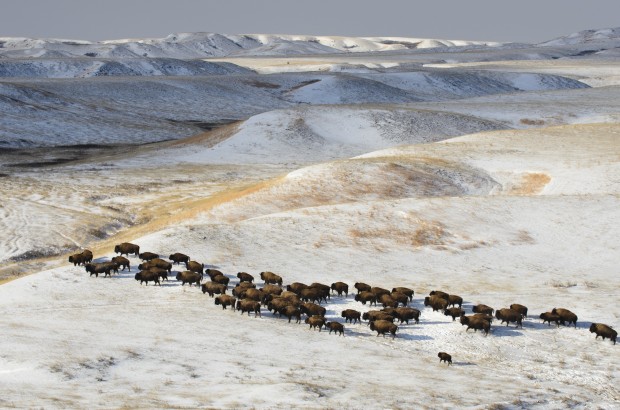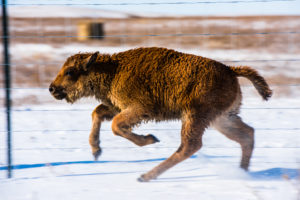We have much more to do and your continued support is needed now more than ever.
Wild Bison Find Their Way Home to Tribal Lands

After spending the day talking with these folks about the importance of Yellowstone bison (the last free-roaming, genetically pure, wild bison herd), I would sojourn on the rivers in Yellowstone, casting flies for trout. Fishing is a time for contemplation, my grandfather always used to say. As I fished, I would think about those tourists and those bison, and how we could get some of those bison back to their historic habitat on America’s grasslands. Those contemplations stayed with me through my graduate studies as I learned and wrote about Native peoples and their cultural and ecological connections to the land and wildlife.

And, today, I’m elated to share with you that I saw the return of 138 Yellowstone bison to the Fort Peck Reservation. In a blog a few weeks ago, I wrote, “With the relocation of 138 bison to the Fort Peck Tribes, we have taken yet another positive step forward in bringing bison back to western landscapes. Doubters have become believers, opponents have become supporters. People now recognize that Tribes are leading the way forward in wild bison conservation.” After several decades of hard work with Tribes and our conservation partners, we are experiencing success after success. You and I both know that means now is the time to go full throttle – let’s keep pushing to get more bison back to tribal and other Western landscapes.
Seeing the bison run out onto tribal land at Fort Peck is exciting and it couldn’t have happened without your support.
[quicktime]http://blog.nwf.org/wp-content/blogs.dir/11/files/2014/11/Bison_plains_4.mov[/quicktime]
What inspires me most is the actions and words of our tribal partners. As Mark Azure, President of the Fort Belknap Tribes, expressed on the day the first Yellowstone bison arrived at Fort Peck, “Today is a great day!” And, as Robert Magnan, Director of the Fort Peck Tribes’ Fish and Game Department and the bison program said, “I’m so proud of the role the Fort Peck Tribes have played in bringing buffalo back. In two years, since we welcomed back the first Yellowstone buffalo, we’ve seen the ecosystem revive. Grassland birds have returned, native grasses are thriving. We welcome and look forward to the buffalo’s continued infusion of new life into our tribal culture and the health of our lands.”
There is nothing more to say than TODAY is a GREAT DAY!





















